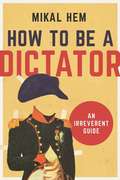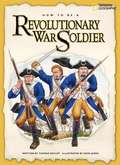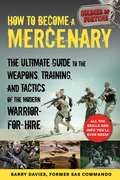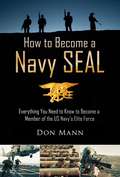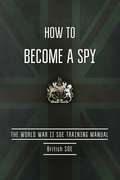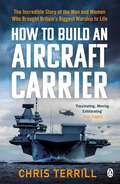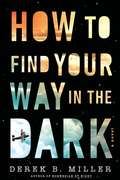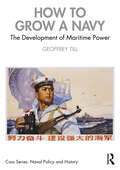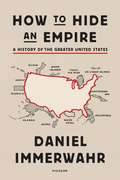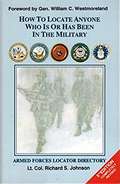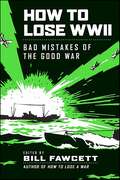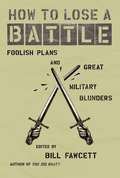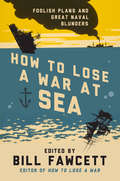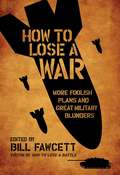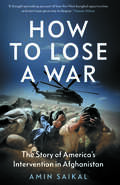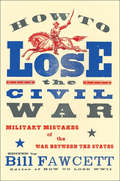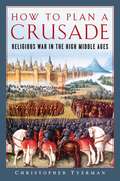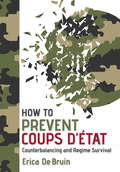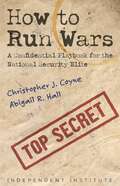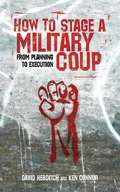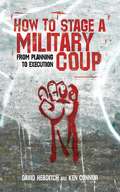- Table View
- List View
How to Be a Dictator: An Irreverent Guide
by Mikal HemA Tongue-in-Cheek Guide to Becoming a Dictator, Based on the Outrageous, Scandalous, and Excessive Behavior of Dictators Past and Present Who hasn’t dreamed of one day ruling your own country? Along with great power comes unlimited influence, control, admiration, and often wealth. How to Be a Dictator will teach you the tricks of the trade-how to rise to the top and stay in power, and how to enjoy the fruits of your excellence.Featuring examples from the most successful leaders and regimes in the business, including Kim Jong Il, Robert Mugabe, Muammar Gaddafi, Nicolae Ceausescu, François "Papa Doc” Duvalier, and many others, this handy guide offers ten easy lessons on becoming and acting like a dictator from how to rig an election and create your own personality cult to the dos and don’ts of dictator fashion. Other topics include: how to become wealthy and spend your fortune, sleeping around, expressing your literary genius, and how to avoid being toppled, exiled, and or meeting any other dismal end. Combining black humor with political insights, How to Be a Dictator is peppered with horrifying and hilarious stories from some of the most eccentric modern world leaders.
How to Be a Revolutionary War Soldier
by Thomas RatliffThese are tense times between Britain and her American colonies. In Boston, tea has been dumped in the harbor and revolution is brewing in the streets. Militias are drilling in town squares and all around you can hear the call of freedom. But how will you be trained? How will you be paid? How will weapons be supplied? And uniforms? What if you are wounded? This abundantly illustrated book will prime you for the interview that will determine your fate-and the war that will forge America’s future. Prepare to answer the call!
How to Become a Mercenary: The Ultimate Guide to the Weapons, Training, and Tactics of the Modern Warrior-for-Hire
by Barry DaviesFor anyone who's ever considered a career as a warrior-for-hire—or who just wants to learn more about the lifestyle—How to Become a Mercenary is the ultimate guide to all the history, training, and equipment information you'll ever need! Mercenaries—who are often trained as part of the best Special Forces, including American Delta Force, British SAS, French Foreign Legion, Marines, SBS, SEALs, and many others—perform one of the most dangerous and feared jobs in the world. Their task is to go into remote locations and remove their targets by any means necessary. They are &“hired hands,&” and have no remorse for their actions. Now, along with Soldier of Fortune magazine, Barry Davies teaches you the training and knowledge that goes into being a mercenary, as well as the history of the profession and how it has evolved. How to Become a Mercenary will teach you everything you&’ve ever needed to know about becoming a mercenary, and also how to excel at it with information on weapons, escape plans, and overall safety. You will learn: • Where and how to find work • How to understand and apply the most modern tactics • What languages to master • Which weapons are preferred • How to disappear after you&’ve completed your job It&’s always been about the money, but in this book, you will learn all the skills that you must acquire before you take your first job. Just remember: Article 47 of the Geneva Convention states that &“a mercenary shall not have the right to be a combatant or a prisoner of war.&” Getting caught is not an option, and in this manual, you will learn how to avoid that at all costs.
How to Become a Navy SEAL: Everything You Need to Know to Become a Member of the US Navy's Elite Force
by Don MannDo you want to be a member of one of the world's most elite special operations forces? Not everyone has what it takes to become a Navy SEAL (Sea, Air, and Land). The training required--and the job itself--is exhausting and demanding, but also exhilarating and highly respected. If you or someone you know is up for the challenge, this book has everything you need to know, from schooling and training to pay range, placement, qualifications, and what you can expect after you become a SEAL. To become a SEAL in the Naval Special Warfare/Naval Special Operations (NSW/NSO) community, you must first go through what is often considered to be the most physically and mentally demanding military training in the world. With this book, you can prepare yourself by learning what to expect before taking on the ruthless and rewarding job of defending your country against foes around the world. This guide includes advice from current and former Navy SEALs on direct action warfare, special reconnaissance, counterterrorism, and foreign internal defense. When there's nowhere else to turn, Navy SEALs are in their element. They achieve the impossible by way of conditioned response, sheer willpower, and absolute dedication to their training, their missions and their fellow special ops team members.
How to Become a Spy: The World War II SOE Training Manual
by British Special Operations ExecutiveDuring World War II, training in the black arts of covert operation was vital preparation for the "ungentlemanly warfare” waged by the Special Operations Executive (SOE) against Hitler’s Germany and Tojo’s Japan. In the early years of the war, the SOE set up top secret training schools to instruct prospective agents in the art of being a spy. Soon there was an international network of schools in operation in secluded locations ranging from the Scottish Highlands to Singapore and Canada. Reproduced here is one of the most comprehensive training syllabi used at SOE’s Special Training Schools (STSs) instructing agents on how to wreak maximum havoc in occupied Europe and beyond. A staggering array of unconventional skills are covered--from burglary, close combat, and silent killing, to utilizing propaganda, surveillance, and disguise--giving an unprecedented insight into the workings of one of WWII’s most intriguing organizations. These files, released from the British National Archive, put covert history in readers’ hands. Uncover an exciting, little-known part of WWII history and delve into the inner workings of a real spy network. Skyhorse Publishing, as well as our Arcade imprint, are proud to publish a broad range of books for readers interested in history--books about World War II, the Third Reich, Hitler and his henchmen, the JFK assassination, conspiracies, the American Civil War, the American Revolution, gladiators, Vikings, ancient Rome, medieval times, the old West, and much more. While not every title we publish becomes a New York Times bestseller or a national bestseller, we are committed to books on subjects that are sometimes overlooked and to authors whose work might not otherwise find a home.
How to Build an Aircraft Carrier: The incredible story behind HMS Queen Elizabeth, the 60,000 ton star of BBC2’s THE WARSHIP
by Chris TerrillDiscover the enthralling story of the HMS Queen Elizabeth, the Royal Navy's largest ever aircraft carrier and SUBJECT OF THE MAJOR NEW BBC DOCUMENTARY SERIES THE WARSHIP'Fascinating, often funny and sometimes moving . . . Terrill takes us deep into the bowels of Britain's biggest warship . . . Exhilarating' THE TIMES________65,000 tons. 280 metres long. A flight deck the size of sixty tennis courts. A giant piece of Sovereign British territory that's home to up to 50 Aircraft. HMS Queen Elizabeth is the biggest ship in the Royal Navy's history and one of the most ambitious and exacting engineering projects ever undertaken in the UK.But it's her ship's company of 700, alongside an air group of 900 air and ground crew that are Big Lizzie's beating heart. And How to Build an Aircraft Carrier tells their story.From before the first steel of her hull was cut, Chris Terrill has enjoyed unprecedented access to Queen Elizabeth and the men and women who have brought her to life. From Jerry Kyd, the ship's inspirational Captain to Lt Cdr Nathan Grey, the first pilot to land Britain's new stealth jet fighter on her deck, Terrill has won the trust and confidence of the ship's people.How to Build an Aircraft Carrier tells the story of Britain at its best: innovative, confident, outward-looking and world beating.________'A detailed account of the challenges, trials and triumphs on the ship's progression . . . and a portrait of the men and women who made it happen. [Terrill] writes with affection, humour and understanding' TELEGRAPH
How to Disappear and Live Off the Grid: A CIA Insider's Guide
by John KiriakouWith an experienced CIA officer as your teacher, you&’ll gain the knowledge and necessary tools to protect yourself and the ones you love.No matter where we go, we leave tracks and clues of our existence without even knowing. Our electronic footprint becomes our invisible trail. In this day in age where the world seems to be at our fingertips and social media plays a huge role in our daily lives, it&’s hard not to leave part of our digital selves for others to find.Whether you&’re fascinated by the idea of disappearing, want to erase your digital footprint, or simply concerned about your safety and privacy, knowing how to become invisible is a survival skill that will come in handy.Through the easy-to-follow instructions, tips, tricks, and professional anecdotes in How to Disappear and Live off the Grid: A CIA Insider's Guide, you&’ll learn to vanish without a trace from John Kiriakou, a former CIA counterterrorism officer and senior investigator for the Senate Foreign Relations Committee responsible for the capture of Abu Zubaydah.
How to Find Your Way in the Dark (A Sheldon Horowitz Novel #1)
by Derek B. Miller"[Miller&’s] character portraits are indelible, often heartbreaking. At times this novel moved me to tears, the highest possible compliment.&”—New York Times Book Review With the wit and scope of Michael Chabon&’s The Amazing Adventures of Kavalier and Clay, Derek B. Miller tackles his most ambitious epic yet. At its heart is the return of Sheldon Horowitz, the protagonist from Miller&’s award-winning first novel, Norwegian by Night, who was lauded by Pulitzer Prize–winning author Richard Russo as &“one of the most memorable characters . . . that I&’ve encountered in years.&”MEET SHELDON IN THE MORNING OF HIS LIFE Twelve-year old Sheldon Horowitz is still recovering from the tragic loss of his mother only a year ago when a suspicious traffic accident steals the life of his father near their home in rural Massachusetts. It is 1938, and Sheldon, who was in the truck, emerges from the crash an orphan hell-bent on revenge. He takes that fire with him to Hartford, where he embarks on a new life under the roof of his buttoned-up Uncle Nate. Sheldon, his teenage cousins Abe and Mirabelle, and his best friend, Lenny, will contend with tradition and orthodoxy, appeasement and patriotism, mafia hitmen and angry accordion players, all while World War II takes center stage alongside a hurricane in New England and comedians in the Catskills. With his eye always on vengeance for his father&’s murder, Sheldon stakes out his place in a world he now understands is comprised largely of crimes: right and wrong, big and small.&“For me—as I&’m certain it will be for every reader of the wonderful Norwegian By Night—Derek B. Miller&’s new novel is a genuine literary event (Sheldon Horowitz is back!). Miller has long deserved to be a household name. How to Find Your Way in the Dark should finally make him one."—Richard Russo, author of Empire Falls and Chances Are...
How to Grow a Navy: The Development of Maritime Power (Cass Series: Naval Policy and History)
by Geoffrey TillThis book examines the large but neglected topic of the development of maritime power from both an historical and a contemporary point of view. Navies have never been more important than they are now, in a century becoming, as widely expected, increasingly and profoundly maritime. The growing competition between China and Russia with the United States and its allies and partners around the world is essentially sea-based. The sea is also central to the world's globalised trading system and to its environmental health. Most current crises are either sea-based or have a critical maritime element to them. What happens at sea will help shape our future. Against that background, this book uses both history and contemporary events to analyse how maritime power and naval strength has been, and is being, developed. In a reader-friendly way, it seeks to show what has worked and what has not, and to uncover the recurring patterns in maritime and naval development which explain past, present and future success - and failure. It reflects on the historical experience of all navies, but in particular it poses the question of whether China is following the same pattern of naval development illustrated by Britain at the start of the 18th century, which led to two centuries of naval dominance. This book will be of much interest to students of maritime power, naval studies, and strategic studies, as well as to naval professionals around the world.
How to Hide an Empire: A History of the Greater United States
by Daniel ImmerwahrA pathbreaking history of the United States’ overseas possessions and the true meaning of its empireWe are familiar with maps that outline all fifty states. And we are also familiar with the idea that the United States is an “empire,” exercising power around the world. But what about the actual territories—the islands, atolls, and archipelagos—this country has governed and inhabited?In How to Hide an Empire, Daniel Immerwahr tells the fascinating story of the United States outside the United States. In crackling, fast-paced prose, he reveals forgotten episodes that cast American history in a new light. We travel to the Guano Islands, where prospectors collected one of the nineteenth century’s most valuable commodities, and the Philippines, site of the most destructive event on U.S. soil. In Puerto Rico, Immerwahr shows how U.S. doctors conducted grisly experiments they would never have conducted on the mainland and charts the emergence of independence fighters who would shoot up the U.S. Congress.In the years after World War II, Immerwahr notes, the United States moved away from colonialism. Instead, it put innovations in electronics, transportation, and culture to use, devising a new sort of influence that did not require the control of colonies. Rich with absorbing vignettes, full of surprises, and driven by an original conception of what empire and globalization mean today, How to Hide an Empire is a major and compulsively readable work of history.
How to Locate Anyone Who Is or Has Been in the Military: Armed Forces Locator Directory
by Richard JohnsonBy the foremost expert in the nation on locating people with a military connection.
How to Lose WWII: Bad Mistakes of the Good War (How to Lose Series)
by Bill FawcettHow to Lose WWII is an engrossing, fact-filled collection from Bill Fawcett that sheds light on the biggest, and dumbest, screw-ups of the Great War. In the vein of his other phenomenal compendiums of amazing battlefield blunders, How to Lose a Battle and How to Lose a War, Fawcett focuses on some amazing catastrophic missteps of Axis and Allies alike.
How to Lose a Battle: Foolish Plans and Great Military Blunders
by Bill FawcettA remarkable compendium of the worst military decisions and the men who made them. The annals of history are littered with horribly bad military leaders. These combat incompetents found amazing ways to ensure their army's defeat. Whether it was a lack of proper planning, miscalculation, ego, bad luck, or just plain stupidity, certain wartime stratagems should never have left the drawing board. Written with wit, intelligence, and eminent readability, How to Lose a Battle pays dubious homage to these momentous and bloody blunders, including: Cannae, 216 B.C.: the bumbling Romans lose 80,000 troops to Hannibal's forces. The Second Crusade: an entire Christian army is slaughtered when it stops for a drink of water. The Battle of Britain: Hitler's dreaded Luftwaffe blows it big-time. Pearl Harbor: more than one warning of the impending attack is there, but nobody listens. How to Lose a Battle includes more than thirty-five chapters worth of astonishing (and avoidable) disasters, both infamous and obscure -- a treasure trove of trivia, history, and jaw-dropping facts about the most costly military missteps ever taken.
How to Lose a War at Sea
by Bill FawcettAn engrossing compendium of high-seas military disasters From the days of the Spanish Armada to the modern age of aircraft carriers, battles have been bungled just as badly on water as they have been on land. Some blunders were the result of insufficient planning, overinflated egos, espionage, or miscalculations; others were caused by ideas that didn't hold water in the first place. In glorious detail, here are thirty-three of history's worst maritime mishaps, including: The British Royal Navy's misguided attempts to play it safe during the American Revolution The short life and death of the Imperial Japanese Navy The scuttling of the Graf Spee by a far inferior force The sinking of the Nazi megaship Bismarck "Remember the Maine!"—the lies that started the Spanish-American War Admiral Nelson losing track of Napoleon but redeeming himself at the Nile The ANZAC disaster at Gallipoli Germany's failed WWII campaign in the North Atlantic Kennedy's quarantine of Cuba Chock-full of amazing facts and hilarious trivia, How to Lose a War at Sea is the most complete volume of nautical failures ever assembled.
How to Lose a War: More Foolish Plans and Great Military Blunders
by Bill FawcettFrom the Crusades to the modern age of chemical warfare and smart bombs, history is littered with truly disastrous military campaigns. How to Lose a War chronicles some of the most remarkable strategic catastrophes and doomed military adventures of overreaching invaders and clueless defenders--whether the failure was a result of poor planning, miscalculations, monumental ego, or failed intelligence . . . or just a really stupid idea to begin with. Alexander invades India--and ends up in deep vindaloo. Sacre bleu! The French are humiliated by Prussia in 1870. spain's "invincible navy" breaks up off the coast of britain while attempting an invasion. the mau mau rebellion against the british in kenya shows us how not to run an insurgency. Chiang Kai-Shek's pathetic army fails to keep Mao's Communists from grabbing China.
How to Lose a War: The Story of America's Intervention in Afghanistan
by Amin SaikalAn incisive, authoritative account of the West&’s failures in Afghanistan, from 9/11 to the fall of Kabul In 1958, Richard Nixon described Afghanistan as &“unconquerable.&” On 15 August 2021, he was proven right. After twenty years of intervention, US and NATO forces retreated, enabling the Taliban to return to power. Tens of thousands were killed in the long, unwinnable war, and millions more were displaced—leaving the future of Afghanistan hanging in the balance. Leading expert Amin Saikal traces the full story of America&’s intervention, from 9/11 to the present crisis. After an initial swift military strike, the US became embroiled in a drawn-out struggle to change Afghanistan but failed to achieve its aims. Saikal shows how this failure was underlined by protracted attempts to capture Osama bin Laden, an inability to secure a viable government via &“democracy promotion&” efforts, and lack of wider strategy in the &“war on terror.&” How to Lose a War offers an insightful account of one of the US&’s most significant foreign policy failures—and considers its dire consequences for the people of Afghanistan.
How to Lose the Civil War: Military Mistakes of the War Between the States
by Bill FawcettA fascinating and fact-filled collection of the greatest and dumbest missteps of America's bloodiest conflict. For four years in the middle of the nineteenth century, brother fought brother on American soil. No American war ever had higher stakes than, or changed a nation as profoundly as, the terrible conflict between the Union and the Confederacy. A dark historical panorama populated by a remarkable cast of colorful characters, the War Between the States was indelibly marked by both brilliant military maneuvers and mind-boggling battlefield blunders that gravely threatened the continuation of the American Experiment. With suitable irreverence, Bill Fawcett chronicles the unbelievably disastrous decisions made by both sides in this monumental clash, including: The Second Battle of Bull Run, where Robert E. Lee looks smart beating a remarkably stupid general; How the Union's shortsighted Colonel James Ripley's bad decision arms the Confederate Army better than his own; Lincoln's roller-coaster search for competent commanders, a long-running dark comedy of tragic errors; A golden opportunity squandered: General Lee fails to exploit a vulnerable Union and capture Washington, D.C.; Pickett's disastrous charge and the many, many Confederate command failures at Gettysburg; Lincoln's contentious draft policy that nearly burns New York City to the ground; and more.
How to Plan a Crusade: Religious War In The High Middle Ages
by Christopher TyermanA spirited and sweeping account of how the crusades really worked—and a revolutionary attempt to rethink how we understand the Middle Ages. The story of the wars and conquests initiated by the First Crusade and its successors is itself so compelling that most accounts move quickly from describing the Pope's calls to arms to the battlefield. In this highly original and enjoyable new book, Christopher Tyerman focuses on something obvious but overlooked: the massive, all-encompassing and hugely costly business of actually preparing a crusade. The efforts of many thousands of men and women, who left their lands and families in Western Europe, and marched off to a highly uncertain future in the Holy Land and elsewhere have never been sufficiently understood. Their actions raise a host of compelling questions about the nature of medieval society. How to Plan a Crusade is remarkably illuminating on the diplomacy, communications, propaganda, use of mass media, medical care, equipment, voyages, money, weapons, wills, ransoms, animals, and the power of prayer during this dynamic era. It brings to life an extraordinary period of history in a new and surprising way.
How to Prevent Coups d'État: Counterbalancing and Regime Survival
by Erica de De BruinIn this lively and provocative book, Erica De Bruin looks at the threats that rulers face from their own armed forces. Can they make their regimes impervious to coups?How to Prevent Coups d'État shows that how leaders organize their coercive institutions has a profound effect on the survival of their regimes. When rulers use presidential guards, militarized police, and militia to counterbalance the regular military, efforts to oust them from power via coups d'état are less likely to succeed. Even as counterbalancing helps to prevent successful interventions, however, the resentment that it generates within the regular military can provoke new coup attempts. And because counterbalancing changes how soldiers and police perceive the costs and benefits of a successful overthrow, it can create incentives for protracted fighting that result in the escalation of a coup into full-blown civil war.Drawing on an original dataset of state security forces in 110 countries over a span of fifty years, as well as case studies of coup attempts in Asia, Africa, Latin America, and the Middle East, De Bruin sheds light on how counterbalancing affects regime survival. Understanding the dynamics of counterbalancing, she shows, can help analysts predict when coups will occur, whether they will succeed, and how violent they are likely to be. The arguments and evidence in this book suggest that while counterbalancing may prevent successful coups, it is a risky strategy to pursue—and one that may weaken regimes in the long term.
How to Profit from Car Boot Sales
by Fiona ShoopThe star of Car Boot Sale Challenge and a keen car booter, Fiona Shoop shares her expertise on how to make the best from car boot sales for both buyers and sellers. Whether youre selling your goods as a one-off to clear the house or buy and sell at car boots to make extra money, Fionas top tips will help make the experience easier, more profitable and even more enjoyable. Fiona also worked as a consultant on several antiques programs where the goods were sold at car boot sales, including Life Laundry and helped the contributors to make as much money and sell as many goods as possible. Fiona also buys and sells at car boot sales in her spare time when not writing the How to Profit from.. series for Remember When.
How to Research your Second World War Ancestors
by Simon FowlerAs the last veterans of the Second World War pass on, more people than ever are researching their stories and seeing what their family did during the Second World War, whether it was just four years peeling potatoes or landing on the D-Day beaches. This comprehensive and easy to use book will set you on the right road.
How to Run Wars: A Confidential Playbook for the National Security Elite
by Christopher J. Coyne Abigail R. HallA copy of the top-secret memo below recently came into our hands, and we thought we should bring it to your attention! &“Dear National Security Elite: In an ideal world, the public would simply accept whatever their leaders—you, in other words—told them. They would comply with restrictions and mandates, not as a matter of mere obedience, but as a matter of unquestionable patriotic duty. But we don&’t live in an ideal world. And with the fate of the world, especially the world&’s wars, in the hands of our enlightened, benevolent, and eminently responsible national security elite—in your hands, in other words—we can&’t afford to risk opening the conversation to an informed public. And we certainly can&’t risk asking for anything so antiquated as &“consent,&” either. Not when the stakes are this high. You simply must learn: How to control the narrative—every narrative—in your favor; How to completely capture the media and effectively quash dissent; How destroying liberty creates more liberty in the long (long) run; Why top-down economic planning, here and abroad, is your best friend; How to flout international, and of course domestic, law and get away with it; And much, much more... The danger with any book like this is, obviously, that it may fall into the wrong hands. If any member of the general public should happen upon these pages, the consequences would be fatal. After all, people may realize that the national security elite—you, in other words—are not, in fact, all-powerful harbingers of peace... They may realize that you are, literally, a force for good... armed and relentlessly attempting to bend the planet to your noble will. And that realization would be nothing short of disastrous. Don&’t let this book fall into the wrong hands!&” Merciless in their penetrating analysis, Christopher J. Coyne and Abigail Hall have written the satirical portrait of America&’s contemporary military-industrial complex. Drawing inspiration from the 1936 classic How to Run a War, by Bruce W. Knight, this book is a must-read for anyone who would know the truth about America&’s endless wars and the people who run them.... The truth might just set us free. It will certainly make you laugh. Then—really angry.
How to Stage a Military Coup: From Planning to Execution
by Ken Connor David HebditchFed up with taxes? Angered and disappointed by corrupt leaders? How to Stage a Military Coup lays down practical strategies that have proven themselves around the globe. David Hebditch and Ken Connor examine, with a critical eye, successful as well as failed coup attempts throughout the twentieth century with the aim of showing their readers just what it takes to swiftly and soundly overthrow a government. Exploring coups from Nigeria, to Cuba, to Iraq, and with true stories of SAS combat written by Ken Connor, the book gives an insightful glimpse into this violent and rarely-seen world of shifting power. How to Stage a Military Coup is a unique textbook for the armchair revolutionary, as well as a practical guide for the idealist with a soft spot for the sound of artillery fire. From evaluation of the political climate and investigation of potential allies, to recruiting and training personnel, to strategies for ensuring timely transfer of power, the book leaves no aspect of the coup d'état unexamined. The book also includes appendixes, notes, and a world map of coups d'état.
How to Stage a Military Coup: From Planning to Execution
by Ken ConnorFed up with taxes? Angered and disappointed by corrupt leaders? How to Stage a Military Coup lays down practical strategies that have proven themselves around the globe. David Hebditch and Ken Connor examine, with a critical eye, successful as well as failed coup attempts throughout the twentieth century with the aim of showing their readers just what it takes to swiftly and soundly overthrow a government. Exploring coups from Nigeria, to Cuba, to Iraq, and with true stories of SAS combat written by Ken Connor, the book gives an insightful glimpse into this violent and rarely-seen world of shifting power. How to Stage a Military Coup is a unique textbook for the armchair revolutionary, as well as a practical guide for the idealist with a soft spot for the sound of artillery fire. From evaluation of the political climate and investigation of potential allies, to recruiting and training personnel, to strategies for ensuring timely transfer of power, the book leaves no aspect of the coup unexamined. This new edition features a new introduction from the authors and a new foreword from an expert in the field, and also includes appendixes, notes, and a world map of coups.
How to Survive a Chemical or Biological Attack
by Hamish de Bretton-GordonThis is an extract from the book Chemical Warrior: Syria, Salisbury and Saving Lives at War by Hamish de Bretton-Gordon (Headline Publishing Group, 2020).
